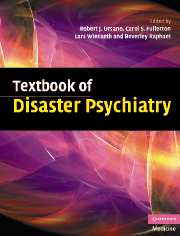Book contents
- Frontmatter
- Contents
- List of contributors
- Preface
- Part I Introduction
- Part II Foundations of disaster psychiatry
- 2 Epidemiology of disaster mental health
- 3 Children and disasters: public mental health approaches
- 4 Disaster ecology: implications for disaster psychiatry
- 5 Neurobiology of disaster exposure: fear, anxiety, trauma, and resilience
- Part III Clinical care and interventions
- Part IV Special topics
- Part V Public health and disaster psychiatry
- Index
- References
5 - Neurobiology of disaster exposure: fear, anxiety, trauma, and resilience
from Part II - Foundations of disaster psychiatry
Published online by Cambridge University Press: 09 August 2009
- Frontmatter
- Contents
- List of contributors
- Preface
- Part I Introduction
- Part II Foundations of disaster psychiatry
- 2 Epidemiology of disaster mental health
- 3 Children and disasters: public mental health approaches
- 4 Disaster ecology: implications for disaster psychiatry
- 5 Neurobiology of disaster exposure: fear, anxiety, trauma, and resilience
- Part III Clinical care and interventions
- Part IV Special topics
- Part V Public health and disaster psychiatry
- Index
- References
Summary
Introduction
To date, clinical and research approaches to disaster mental health have focused primarily on the psychological experience of disaster survivors, and the development and effectiveness of psychological treatments. While these studies have contributed greatly to our understanding of the human response to disaster, it has become clear in recent years that, in addition to psychological approaches, neurobiological approaches to disaster-related psychopathology and resilience are also potentially informative.
Multiple neurobiological systems are involved in the human response to threat. Simultaneous activation of various brain regions and neurotransmitter systems allows the organism to assess and appropriately respond to potential dangers. This dynamic process contributes to the development of anxiety, fear, and the “fight or flight” response that allows the organism to protect itself by either fleeing from, or actively confronting, danger. Fear triggers the familiar “fight or flight” response, characterized by acute increased heart rate, breathing, and muscle tension, which facilitate escape from danger or defense against danger (e.g., predator). Based on a complex process of recognition and appraisal of internal and external stimuli, the brain regulates the strength and duration of this coping mechanism, and generally turns it off when it is appropriate to do so. Malfunction of regulatory systems, however, can lead to excessive fear, anxiety disorders such as post-traumatic stress disorder (PTSD) and significant impairment and disability in vulnerable individuals.
Keywords
- Type
- Chapter
- Information
- Textbook of Disaster Psychiatry , pp. 97 - 118Publisher: Cambridge University PressPrint publication year: 2007
References
- 3
- Cited by



